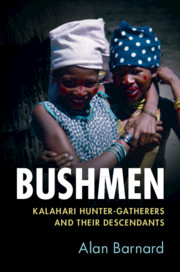Book contents
- Bushmen
- Bushmen
- Copyright page
- Contents
- Figures
- Tables
- Preface
- Pronunciation and Orthography
- 1 Bushmen
- 2 The Politics of Indigeneity
- 3 How Far Back Can We Go?
- 4 Discovery and Destruction of the /Xam
- 5 The !Xoõ and Their Neighbours
- 6 G/wi, G//ana and the Central Kalahari
- 7 Naro
- 8 Ju/’hoansi or !Kung
- 9 Hai//om
- 10 Bushmen of the Okavango
- 11 Sharing the Land with Others
- 12 Conclusions
- References
- Index
- References
5 - The !Xoõ and Their Neighbours
Published online by Cambridge University Press: 11 July 2019
- Bushmen
- Bushmen
- Copyright page
- Contents
- Figures
- Tables
- Preface
- Pronunciation and Orthography
- 1 Bushmen
- 2 The Politics of Indigeneity
- 3 How Far Back Can We Go?
- 4 Discovery and Destruction of the /Xam
- 5 The !Xoõ and Their Neighbours
- 6 G/wi, G//ana and the Central Kalahari
- 7 Naro
- 8 Ju/’hoansi or !Kung
- 9 Hai//om
- 10 Bushmen of the Okavango
- 11 Sharing the Land with Others
- 12 Conclusions
- References
- Index
- References
Summary
The !Xoõ of Botswana, northern-most ‘Southern Bushmen’ will be treated here. The ethnography (originally an MA thesis by ‘Doc’ Heinz) dates from the 1960s, but it is of very high quality and the thesis quite lengthy, at least for its time. Since then Gertrud Boden has worked with this group (and others), and she has proved material on social change especially in the fringe areas of the !Xoõ region. The !Xoõ may be less well known than the /Xam, but their existence points to the wide historical extent of the ‘Southern’ Khoisan language family. In addition to the !Xoõ, other groups are present, including the N!aqriaxe (who also sometimes call themselves !Xoõ). Other peoples are present too, and the ethnography is becoming more complex. The impact of the environment on these isolated peoples, as well as their reputed belligerence, also calls for discussion.
Keywords
- Type
- Chapter
- Information
- BushmenKalahari Hunter-Gatherers and Their Descendants, pp. 73 - 85Publisher: Cambridge University PressPrint publication year: 2019

